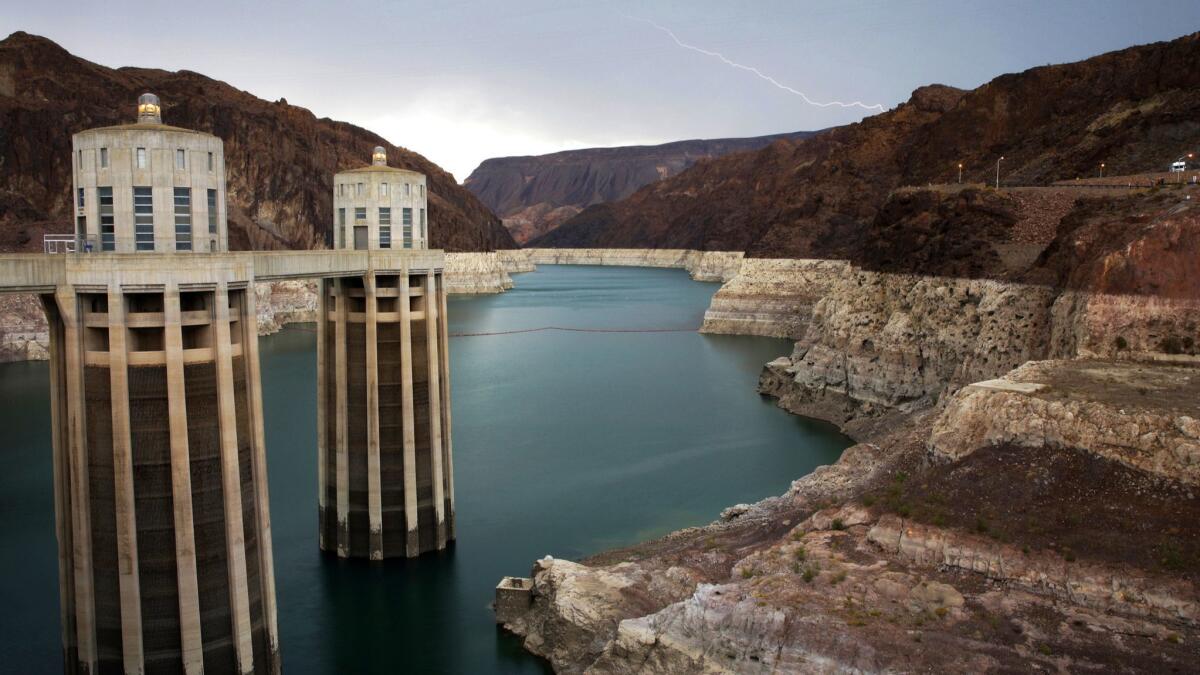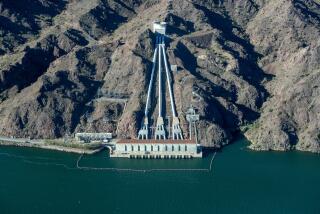MWD may agree to more Colorado River cuts to seal drought pact

Frustrated by delays in agreeing to plans for coping with looming shortages on the Colorado River, the head of the Metropolitan Water District of Southern California wants to move the deal forward by agreeing to shoulder additional supply cuts.
If the proposal is approved by the Metropolitan board, California would join a multi-state drought contingency plan and the water district would ensure its access to reserves stored in Lake Mead.
“I believe the pros outweigh the cons,” said Metropolitan General Manager Jeffrey Kightlinger, whose agency supplies Los Angeles and the rest of the urban Southland.
California and Arizona both missed a key deadline this month to finalize agreements for the drought plan drafted by the seven Western states that depend on Colorado River supplies.
Although Arizona appears ready to wrap up its end of the deal, California has been stymied by the Imperial Irrigation District.
Imperial, a sprawling agricultural district east of San Diego, says it won’t sign off until the federal government sends money it was promised for restoring the Salton Sea.
Kightlinger’s proposal would bypass the need for Imperial’s signature by assuming responsibility for the irrigation district’s future delivery cuts — in addition to those expected of Metropolitan.
He said he would ask the board to approve the workaround at its March 12 meeting.
“I believe we need the drought contingency plan,” Kightlinger said. “I believe the entire system is in danger.”
If California and Arizona fully agree to the drought plan, that would head off action by the U.S. Bureau of Reclamation, which oversees management of the lower Colorado River.
Reclamation Commissioner Brenda Burman has warned that the federal government will develop its own shortage plans if the Colorado River basin states don’t agree on how to share the burden of delivery cuts.
Nearly two decades of drought have depleted the river and the huge reservoirs that fill faucets and irrigation ditches from Colorado to Southern California. Federal water managers have repeatedly warned that the time is approaching when they will have to formally declare a shortage, triggering a cascade of river rationing.
Under the drought plan, Arizona, Nevada and California would reduce their withdrawals from Lake Mead in progressive steps to keep the reservoir’s levels from dropping low enough to jeopardize hydropower production and, eventually, water releases.
Imperial has senior rights to the largest water allocation on the entire river and diverts the bulk of California’s share of the Colorado.
Metropolitan takes the second-biggest share of California’s diversions.
Imperial has agreed to the broad outlines of the multi-state shortage plan, but before district directors ink the final documents, they want the federal government to provide $200 million for Salton Sea restoration work.
The lake is sustained by irrigation runoff from the Imperial Valley. But as Imperial sold some of its river water to San Diego, both irrigated acreage and field runoff declined, causing the lake to shrink.
As the shoreline recedes, parts of a lake bed laced with farm chemicals and other pollutants have turned to dust, fouling the air. The lake has also grown increasingly salty, worsening its already bad water quality.
All that was anticipated when the San Diego water sales were agreed to more than a decade ago. The state and federal governments promised costly restoration programs. But they have been slow to materialize.
Imperial officials say they are optimistic they can line up the $200 million in federal funds, paving the way for board approval of the drought accord.
“I think everybody is trying to resolve the matter,” said Henry Martinez, Imperial’s general manager. “We’re not just sitting around.”
But it’s not happening fast enough for Kightlinger, who is concerned about Lake Mead.
Under a 2007 agreement, Metropolitan, Imperial and agencies in Arizona and Nevada have been allowed to store reserves in Lake Mead for future withdrawal. But if a river shortage is declared, those withdrawals would end.
Kightlinger said he wants the drought plan to go into effect as soon as possible so the states can take steps to avert a shortage declaration and maintain access to their Lake Mead reserves.
Metropolitan’s staff calculated the agency would wind up with more water if it absorbs Imperial’s future cuts than it would if reserves were locked up in Lake Mead, Kightlinger said.
“Being able to bank water and have access to it is worth it,” he said.
Kightlinger said the reaction was positive when he floated his proposal Monday at a Las Vegas meeting with Burman and representatives of neighboring states.
Imperial officials were also at the meeting. “They wanted us to keep waiting until the Salton Sea is resolved. I said, ‘It doesn’t seem to be any closer,’ ” Kightlinger recalled.
If Metropolitan does seal California’s end of the deal, Imperial could join later, Kightlinger added. And if that happens, Metropolitan would no longer be responsible for the cuts intended for Imperial.
Twitter: @boxall
More to Read
Sign up for Essential California
The most important California stories and recommendations in your inbox every morning.
You may occasionally receive promotional content from the Los Angeles Times.











